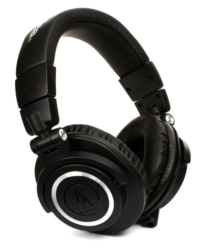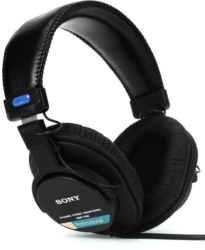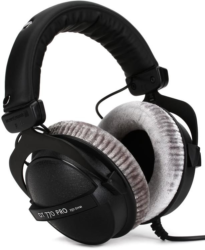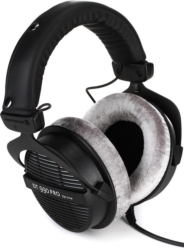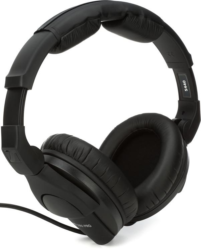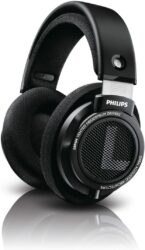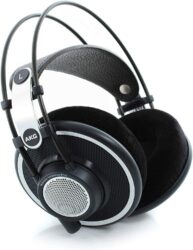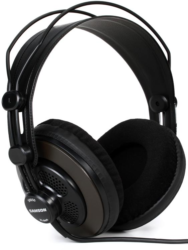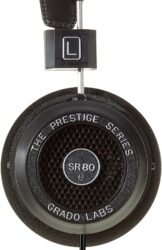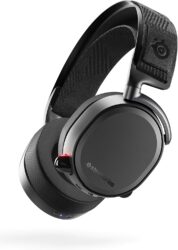Whether you’re a sound engineer, a musician, or just an avid audiophile, if you’re in pursuit of great sound you’ll undoubtedly come across studio headphones at one point or another.
Unlike ordinary headphones, studio headphones are special because they process sound differently. Some of them isolate sound to such an extent that you’ll hear nothing else but the sound you’re listening to. Others have special features that allow you to hear the sound exactly as recorded, without distortions and modifications.
If that sound good to you, then congratulations – you’re in the right place. This article will tell you everything you need to know about the best studio headphones you can buy in 2025.
- What to Consider When Buying Studio Headphones
- Top 10 Best Studio Headphones 2025
- 1. Best Overall Headphones: Audio-Technica ATH-M50x
- 2. Best Budget Headphones: Sony MDR-7506
- 3. Best Premium Headphones: Beyerdynamic DT 770 PRO 250 Ohm
- 4. Best Open-Back Headphones: Beyerdynamic DT 990 PRO
- 5. Best Noise-Isolating Headphones: Sennheiser HD280 PRO
- 6. Philips SHP9500
- 7. Best-Looking Headphones: AKG Pro Audio K702
- 8. Best Semi-Open Headphones: Samson Technologies SR850
- 9. Best Simple Studio Headphones: Grado SR80e Prestige Series
- 10. Best Wireless Studio Headphones: SteelSeries Arctis Pro Wireless
- The Ultimate Buyer’s Guide to Studio Headphones
- Final Thoughts
What to Consider When Buying Studio Headphones
Before you purchase a pair of studio headphones, there are some factors that you need to consider first.
Open- vs. Closed-Back
Different kinds of studio headphones are made for specific purposes. Studio headphones are primarily separated into open- and closed-back varieties (with semi-open options offering a good midpoint between them), and the only way to get the most out of your headphones is if you know exactly what you’re going to use them for.
Each type will have its features, advantages, and disadvantages, all of which will be tackled in-depth later in the article.
For instance, if you’re a vocal artist, a sound creator, or a die-hard music listener who wants to work with sound in its purest form, then closed-back headphones will work best for you. They isolate and express vibrations so that you will only be hearing pure sound without any adjustments.
But if you’re a sound mixer or a DJ who wants to master sound synthesizing, then open-back headphones should be your pick. This type of studio headphones reduces unwanted reflected sound waves, something that often happens with other types.
Performance
You should also consider the specifications and features offered before buying studio earphones. Things such as noise isolation, frequency response, impedance, drivers, and more will play a large role in the quality of the sound you’ll get from your chosen unit. Such features will be discussed much more thoroughly down below.
Value
Studio headphones can easily become quite pricey, definitely more than ordinary headphones. However, there are excellent options that will not break the bank, as long as you’re prepared to sacrifice some higher-end functionalities. After all, features and performance are always closely tied to the price.
Before shopping for your studio headphones, you should establish how much you’re willing to spend first. This way, you will have an easier time choosing between the products which are available to you.
With that out of the way, here are the top 10 studio headphones you can buy in 2025.
Top 10 Best Studio Headphones 2025
1. Best Overall Headphones: Audio-Technica ATH-M50x
Why we like it:
Anybody who has ever seriously worked with audio has likely heard of the Audio-Technica M-Series product line, especially the ATH-M50x, with its professional, high-quality performance and unmatched audio experience.
Quick Specs:
- Type:Closed-back
- Frequency:15Hz to 28 kHz
- Impedance:38 Ohms
- Connections:Detachable cable
Audio-Technica’s ATH-M50x is sweeping the market for a reason.
Its large, well-padded ear cups and headband provide excellent sound isolation and comfort even through long sessions. It also has detachable cables that come in three different lengths, swiveling ear cups, and four different color schemes to match your personal style.
It has a durable steel and plastic construction that doesn’t sacrifice sound quality. The sound remains even and accurate, perfect for some light recording, mixing, and mastering. It also features an extended frequency range.
That said, the ATH-M50x does leak quite a bit of sound despite its closed-back design. You may want to avoid using this if you’re planning to use it for recording with ultra-sensitive microphones, as some sounds may get picked up—try the Sony MDR-750 instead, but keep in mind that the audio itself won’t sound quite as crisp.
The unit also doesn’t have an in-line remote or built-in control functions, so it’s not ideal for casual use, such as quickly changing the music without having to unlock your device.
Lastly, it’s relatively more expensive than its competitors. The price is worth it though, considering you’re getting one of the highest quality pairs of studio headphones that money can buy.
Pros
- Superb sound isolation
- Even and accurate sounds
- Comfortable even with long use
- Durable steel-and-plastic build
- Convenient, detachable cables
Cons
- Sound leakage present
- Relatively expensive
- Not convenient for casual listening
2. Best Budget Headphones: Sony MDR-7506
Why we like it:
Sony certainly doesn’t disappoint with the time-tested MDR-7506 and its wonderfully neutral sound qualities, solid construction, and premium features – all for an astonishingly budget-friendly price.
Quick Specs:
- Type:Closed-back
- Frequency:10 Hz to 20 kHz
- Impedance:63 Ohms
- Connections:Fixed cable
Despite its affordable price, the Sony MDR-7506 is a familiar name when it comes to audio-professional circles.
Its mostly-aluminum build reflects Sony’s commitment to creating high-quality pieces that will stand the test of time. The earpads provide excellent sound isolation, balanced with comfortable padding and gentle clamping that can minimize fatigue even after long hours of wear. Audiophiles will love the truly neutral sounds, as it makes sound mixing, equalizing, and even monitoring much easier. We’ll explain this concept further below in this guide.
For nitpicky and stylish users, however, the headphone’s design may be too plain, lacking the flair and hype that somehow characterizes working in the sound industry. The cables are also fixed, so you can’t take them off to move them around. You also can’t change the length conventionally.
But considering the low price that you’ll be getting the Sony MDR-7506 for, these drawbacks typically won’t matter—though those that prize aesthetics or want a cordless set might want to look at the wireless SteelSeries Arctis Pro Wireless.
Pros
- Excellent value for price
- Great noise isolation
- Superb sound quality
- Durable metal components
- Fatigue-minimizing design
Cons
- Design is plain
- Fixed cables
Why we like it:
Beyerdynamic has been making a name in the sound industry ever since 1924, and its long-standing name speaks to its quality construction, professional-grade sound quality, and unmatched use experience – all exemplified by the DT 770 PRO 250.
Quick Specs:
- Type:Closed-back
- Frequency:5 Hz to 35 kHz
- Impedance:32, 80, and 250 ohms
- Connections:Fixed cable
Although the DT 770 PRO 250 isn’t for those on a tight budget, they do offer the perfect quality to match the premium price.
The headphones are made of a combination of plastic and metal that’s guaranteed to last you a long time. It has a lightweight metal headband wrapped in leather and velour-cushion ear pads, which results in the ideal clamping force and a cozy fit that minimizes fatigue. You can even choose from 32, 80, and 250 ohms of impedance to suit your needs.
A good build isn’t all it has, too. The sound quality it renders on par with the brand’s high standards, as it’s got all the ranges covered and delivered straight to your ears.
One area where this model kind of falls flat is sound isolation. Some sounds can still penetrate the headphones even at medium volume. If that’s important to you, the Audio-Technica ATH-M50x might be a better bet, but they’ll unfortunately leak a bit more sound than this model.
We also found the mids to be a little recessed compared to the bass and treble. The cables don’t detach and the headphones themselves don’t fold for a compact take-down. But overall, these are minor issues compared to the great value that the DT 770 PRO 250 delivers.
Pros
- Highly comfortable
- Premium, long-lasting build
- Extremely lightweight
- Superbly rendered sound quality
- Choice of 3 impedance models
Cons
- Slightly recessed mid sounds
- Imperfect sound isolation
- Headphones don’t fold and cord isn’t detachable
4. Best Open-Back Headphones: Beyerdynamic DT 990 PRO
Why we like it:
This guide wouldn’t be complete without another one of Beyerdynamic’s classics – the solid, high-performance, and professional-grade neutral sound quality of the open DT 990 Pro makes it a beloved unit in audiophile circles.
Quick Specs:
- Type:Open-back
- Frequency:5Hz - 35kHz
- Impedance:250 Ohms
- Connections:Fixed cable
As an open-back counterpart to the DT 770 PRO 250, the Beyerdynamic DT 990 Pro matches its partner in terms of build and sound quality.
It has a rugged metal frame that can withstand a significant amount of stress. The ear cups are plastic, but it’s made from the sturdy kind rather than the flimsy kind. They also look very high-end, with their suede-like covering and metal headband that is adorned with detachable padding.
Sound-wise, the DT 990 Pro reproduces sounds with high-fidelity, rendering vocals, instruments, and bass alike with the high standard that we’ve come to expect with Beyerdynamic. The sounds are sometimes a bit sharp, though, and the treble can be a little too emphasized compared to the rest.
The brand could’ve done better than the plastic ear cup covering, as it slightly reduces the comfort and durability of the unit, especially considering the price. Also, the metal headband leads to stronger clamping force, which can become distracting when used for a long time. The open AKG Pro Audio K702 offers far superior comfort areas, but it’s not cheap.
Pros
- High-end aesthetics
- Sturdy, durable build
- High-fidelity sounds
Cons
- Plastic cup cover reduces durability
- Tighter than expected
- Sounds a bit sharp at times
5. Best Noise-Isolating Headphones: Sennheiser HD280 PRO
Why we like it:
Our list wouldn’t be complete without the superb sound quality and out-of-this-world sound isolation capabilities of the Sennheiser HD280 Pro.
Quick Specs:
- Type:Closed-back
- Frequency:8 Hz to 25 kHz
- Impedance:64 Ohms
- Connections:Fixed cable
Although many would likely balk at the mostly-plastic build of the HD280 PRO, it does help provide a lightweight yet durable design.
The ear cups swivel, rotate, and fold, which makes for easier transport. This unit also doesn’t skimp on comfort, providing replaceable cushioning not only on the ear cups but also on the headband – all of which provides superb sound isolation capabilities that not only doesn’t leak the sound out but also doesn’t let anything creep in. The sound quality is superb, coming out wonderfully neutral and equalized.
If there’s anything worth picking on about this model, it would be the strong clamping grip of the headband, which takes a while to loosen up and could be rather uncomfortable. Also, compared to other headphones, it looks quite plain aesthetically speaking. Lastly, fans of portability and convenience may not like the fixed cable design.
Pros
- Comfortable replaceable padding
- Lightweight and sturdy build
- Convenient rotating and folding ear cups
- Superb sound isolation capabilities
- Equalized, neutral tone rendering
Cons
- Plain aesthetics
- Strong initial clamping grip
- Fixed cable design
6. Philips SHP9500
Why we like it:
The durability, comfort, sound rendition, and sheer value that the SHP9500 delivers is a jewel in the Philip brand’s crown.
Quick Specs:
- Type:Open-back
- Frequency:12 to 35 kHz
- Impedance:32 Ohms
- Connections:Detachable cable
Another giant name in the sound-making industry, Philips is a classic when it comes to the studio headphones game.
Made of a wonderfully designed mixture of aluminum and plastic, the Philips SHP9500 is durable enough to withstand the test of time. The headband is a sturdy metal-encased with stiff matte plastic, while the open-back ear enclosures are encased with plastic mesh and covered on the ear-side with a breathable, heat-dissipating cloth-and-foam combination.
When it comes to aesthetics, we personally find the earpads with the bold “L” and “R” lettering, to be rather cool. It even has a detachable cable.
Sound production does not disappoint, although it does have somewhat inconsistent bass. Nevertheless, the boom and rumbles are distinct and the highs are crystal clear. It also renders subtle lows and mids. Aside from the inconsistent bass sound, we also picked up a slightly uneven treble rendering coming from the SHP9500.
Looks-wise, if you’re looking for some flair and flash, the understated aesthetics of this model isn’t for you. Build-wise, the padding is non-replaceable, which is bad should the padding wear out eventually.
Pros
- Good value for the price
- Solid build quality
- Comfortable to use
- Detachable cable
Cons
- Plain aesthetics
- Inconsistent bass and uneven treble
- Non-replaceable paddings
7. Best-Looking Headphones: AKG Pro Audio K702
Why we like it:
The beautiful AKG Pro Audio K702 is made for the professional, with great response agility and sound spaciousness that produces a wonderfully neutral range of tones that is perfect for precision mastering, mixing, and monitoring.
Quick Specs:
- Type:Open-back
- Frequency:10 Hz to 39.8 kHz
- Impedance:62 ohms
- Connections:Detachable cable
Even at the very first glance, you can see that the construction of this AKG model speaks of quality. Durability meets comfort meets portability with the metal-and-leather headband coupled with soft velour cushions of the ear enclosure and plastic component construction. The final look is rather classy, with its elegant matte black finish.
In terms of sound production, the unit boasts “revolutionary” coils and its own patented two-layer diaphragm dubbed Varimotion. These claims seem lofty, but you can’t argue with the results. The sound is clear, flat, and neutral – with exceptional bass response, musical trebles, and balanced lows and mids.
If there’s anything to say against the AKG Pro Audio K702, it would be that for its price, it doesn’t come with a storage case nor does it fold up. This is quite a pity since it’s one of the bulkier units around. However, it does compensate for it by having detachable cables. Lastly, the mostly-plastic component make-up does cast doubts as to its durability.
Pros
- Wonderfully neutral sounds
- Elegant, understated aesthetics
- Comfortable velour cushioning
- Detachable cable
- Innovative sound-production technology
Cons
- Not very portable
- Pricier than the competition
- Fragile components
8. Best Semi-Open Headphones: Samson Technologies SR850
Why we like it:
Samson Technologies’ SR850 is a surprisingly high-quality pair of studio headphones that doesn’t break the bank, delivering quality, long-lasting build, excellent sound production, and seamless style — all for an extremely budget-friendly price.
Quick Specs:
- Type:Semi-open
- Frequency:10Hz - 30kHz
- Impedance:32 ohms
- Connections:Fixed cable
The Samson SR850 takes a lot of inspiration from the more-established AKG models, but for a much lower price. Although many critics complain that these are simply AKG clones, they’re very good ones that merit a spot on our list.
The unit is made mostly of plastic, with the ear enclosures padded with a simple but thick and comfortable fabric that protects the ears from long hours of use. The sounds that it produces are clear, solid, and neutral enough – with full bases, sharp trebles, and distinguishable mids and lows.
However, it does lack a lot of the depth and subtlety that more expensive brands like Sony or Beyerdynamic have. Although it’s only semi-open, it does leak a significant amount of sound, so it might be a wise idea to treat these babies as if they’re fully open. Also, they don’t look the best, which may disappoint more fashion-forward users. Lastly, it has fixed cables which can be inconvenient to set up and takedown.
Pros
- Excellent value for money
- Does not skimp on comfort
- Clear, neutral sounds
- Very budget-friendly
Cons
- Plain aesthetics
- Leaks a lot of audio
- Fixed cables
9. Best Simple Studio Headphones: Grado SR80e Prestige Series
Why we like it:
The essence of studio headphones is the pursuit of sound in its most basic form, and no other model exemplifies this quality than the plain, no-frills, and reliable approach of the Grado SR80e model.
Quick Specs:
- Type:Open-back
- Frequency:20Hz - 20KHz
- Impedance:32 ohms
- Connections:Fixed Cable
If you’re looking for three words to best characterize the Grado SR80e Prestige Series, it will be clean, crisp, and simple.
Just by looking at its plastic, metal, synthetic leather, and thick foam construction, rotating ear enclosures, and no-frills aesthetics, you will know that these studio headphones mean nothing but business. Each frequency is well defined, from the lows to the highs, even to the subtle mids. The overall sound quality remains extremely clear and pure regardless of the genre.
Although it’s quite lightweight compared to other headphones, one of its most significant drawbacks is the fact that long usage can cause fatigue. Because of the way that it’s designed for sound, there’s less padding, which means vibrations are closer to your ears. It also doesn’t include a storage case and has a fixed cable that can’t be detached for easy take-down.
Pros
- Excellent sound quality
- Lightweight design
- Solid build quality
- Rotating ear enclosures
Cons
- Minimal foam padding
- Doesn’t come with a storage case
- Non-detachable wiring
10. Best Wireless Studio Headphones: SteelSeries Arctis Pro Wireless
Why we like it:
If you’re looking for convenience in your studio use, then the non-compromising build quality, superb convenience, and dedicated sound rendition of the SteelSeries Arctis Pro Wireless will certainly strike your fancy.
Quick Specs:
- Type:Closed-back
- Frequency:10 Hz to 40 kHz
- Impedance:N/A
- Connections:Wireless
If you’re usually on the go or if you’re interested in streamlining your music-production process, then this model is certainly right for you.
Built with a sleek, modern-looking mixture of metal and plastic, the Arctis Pro offers convenience without compromising sound. It has 15 hours of battery use from a single charge, and even packs something extra in the base of their wireless transmitter. It comes with a sound-customization app, replaceable batteries, and a high-quality microphone. The sound it produces is wonderfully neutral, with all sound frequencies rendered equally.
Unfortunately, the durability of these units is quite subpar, at least based on many user reviews. Worse, it’s hard to get customer service to have the unit replaced or refunded. Lastly, even though they’re closed-back headphones, they do leak quite a bit of noise, so we don’t recommend using them in high-sensitivity recording sessions. They’re fine for messing around or listening to music, but pros should choose something with a hard connection like the Beyerdynamic DT 770 PRO 250.
Pros
- Excellent sound
- Long battery life
- Comes with sound modifying app
- High-quality microphone
- Sleek, modern aesthetics
Cons
- Subpar build quality
- Leaks noise
- Terrible customer service reputation
The Ultimate Buyer’s Guide to Studio Headphones
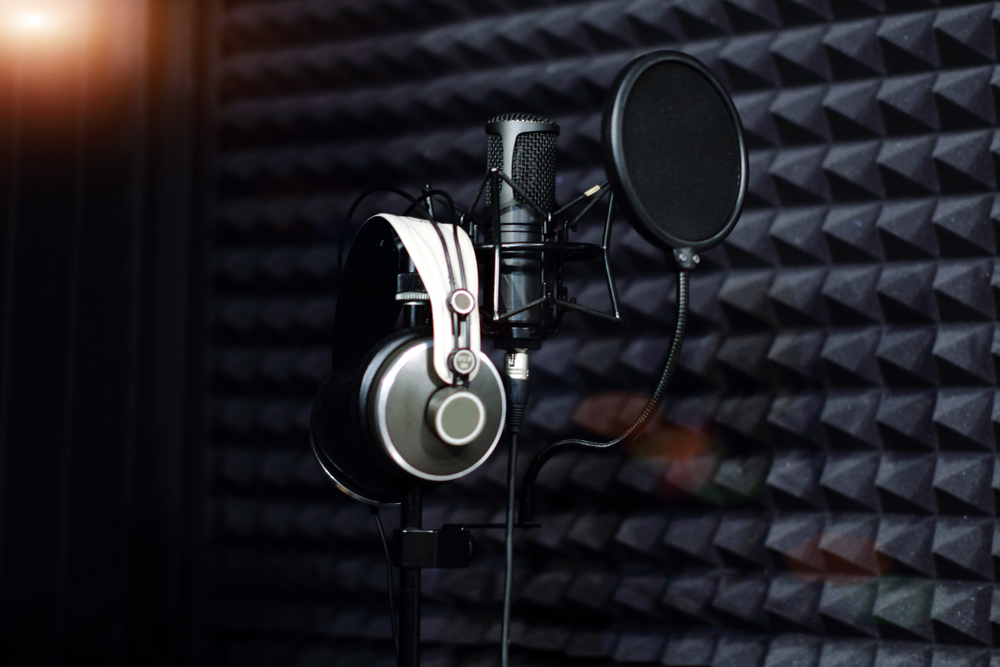
If you’re on a journey to find the best sound experience that money can buy, then studio headphones are the highway to it.
Sadly, these things don’t come cheap, and nobody wants to spend their hard-earned money on something that will only last a short time. If you’re an audiophile, especially one that’s on a budget, it’s important to pick a unit that will give you the most bang for your buck.
To help you out, here’s our ultimate guide to choosing the best studio headphones for you this 2025!
What Are Studio Headphones?
If you’re someone who works with sound, then you know the lengths professionals take to control audio.
If you’re recording audio, for example, you don’t want your microphones to pick up anything else other than the specific voice or instrument that you’re currently working with.
Unfortunately, that’s easier said than done. Professionals go through great pains to sound-treat their recording studios so that the microphone picks up only the preferred sounds and nothing else.
Studio headphones are the same. Normal headphones, earphones, or speakers sometimes come with sound modifications, like heavier bass sounds. Not studio headphones, however. That’s because when you’re creating a song, orchestrating a track, or engineering sound, you want only neutral vibrations. Therefore, studio headphones come with special features such as flat frequency response and sound isolation, among other things, that will give you the purest sounds possible.
Studio Headphones vs. Regular Headphones
Studio headphones are as different from regular headphones as pure black coffee is to a cappuccino.
Regular headphones, typically called consumer headphones in the audio industry, deliver “treated” sound, which means that the original sound is modified for the personal and subjective enjoyment of consumers. In contrast, studio headphones create neutral sounds, which makes it easier for audio professionals to master, mix, and work with the audio.
Explaining Neutral Sounds in Studio Headphones
The ability to deliver neutral sounds is perhaps the biggest advantage of getting studio headphones. To say it simply, neutral or flat sounds refer to sounds that are produced as close to the original electrical signals as possible.
In consumer headphones, manufacturers ‘treat’ the output sound of their products to cater to their consumers’ preferences. For example, most people prefer listening to bass-heavy music, while others prefer acoustics or vocal sounds to take precedence.
This isn’t the case with studio headphones, which produce neutral or flat sounds. This allows recording artists, composers, sound mixers, DJs, and other audio professionals to work with sound in its clearest, purest form.
Benefits of Using Studio Headphones
Studio headphones are obviously very useful for people who work with and around sound. Here are some of the reasons why using studio headphones is beneficial to anyone, even to the non-audio professional.
Accurate Audio
If you’re simply a music lover, any quality pair of headphones is usually enough to deliver your happy-sounds. But if you’re a true audiophile, then you may want to listen to how the music was actually performed. With studio headphones, you can listen to your favorite music in its purest form.
Want to recreate the auditory experience of a band concert or a live performance? Put on a good pair of studio headphones that’s designed to accurately reproduce audio, close your eyes, and let the sound transport you to that moment. It’s the closest you’ll ever get to time travel.
Raw Sound Creation
Audio is already subjective enough when it comes to individual tastes, and if you’re any kind of professional that deals with sound, you don’t want to add hardware distortions and modifications into the mix. You’ll be able to create a clearer, more consistent output if you start from a neutral place, without all the bells and whistles added by common headphones.
If you’re using studio headphones, you’re dealing with raw sound, not at all like the modified sounds from common earphones. This is akin to a chef that cooks up the best meals from raw ingredients, rather than simply microwaving a dish and spicing it up with a little garnish.
Hassle-Free Recording
With studio headphones, recording your professional or home music has never been easier. They have prime noise-isolation features that you can use to listen only to the sound that you’re actually listening to. They’re also specialized not to leak sounds so that your recording microphone won’t pick up the unnecessary noise. If it’s recording you have in mind, be sure to pick up a pair of closed-back headphones with good noise isolation.
Different Types of Studio Headphones
Studio headphones are not all the same. Like most things, some types are better suited for certain niches, and each one has its own features, advantages, and disadvantages.
Open-Back Studio Headphones
Open-back studio headphones like the Beyerdynamic DT 990 PRO are made to minimize sound pressure by releasing it through the open back. When earphones generate sound, they usually create sound pressure inside the enclosures that cup your ears. Over time, this can result in sound distortions as they mix and clash with original soundwaves, which can be catastrophic to the wearer, depending on the circumstance.
To solve this problem, open back studio earphones release the sound pressure through its backside so that it can’t build up and cause potentially-damaging distractions. This makes open-back studio headphones the ideal choice for avoiding long term fatigue, which is especially important to DJs, sound mixers, and live acoustic performers, as they all rely on being able to listen to pure sounds for long periods at a time.
Closed-Back Studio Headphones
Closed-back studio headphones like the Audio-Technica ATH-M50x do not have any opening to release sound pressure. This means that sound pressure will build up if used non-stop for a long time, but as a trade-off, you’ll be able to hear sounds clearer and without distractions.
Closed-back headphones also typically do not leak sound. Because of this, closed-back studio headphones are ideal for people who need to professionally record sounds, such as singers, songwriters, or musicians. Since sounds will not be leaked outside, this ensures that they will not be picked up by even the most ultra-sensitive recording microphones.
Semi-Open Studio Headphones
Offering the best of both worlds, semi-open studio earphones, such as the Samson Technologies SR850, have mostly-enclosed cups for the ears, but with small holes at the back. This allows the unit to still be able to release sound pressure while sufficiently isolating sounds, letting the wearer hear pure audio with minimal background distractions. This means that they’re not as fatigue-inducing to wear for long periods as headphones that are fully closed-back.
If you can’t afford to have both types at the same time, then this type is a good compromise. For casual, home-studio users, semi-open studio headphones are most ideal. You can also use these for sound mixing, and even for vocal sessions if your recording microphone is not too sensitive, as semi-opens can still leak sounds.
Important Features of Studio Headphones
Now that we know the different types of studio headphones, it’s time to discuss the features. Looking at the features is a good way to gauge whether or not the product is a perfect fit for your intended use, so make sure you consider them thoroughly.
Frequency Response
Frequency response refers to the sound range that your headphones can produce. Most people can hear anywhere between 20 to 20,000 Hertz (Hz). Bass sounds typically refer to sounds in the range 20 to 400 Hz, mids in the range 400 Hz to 4,000 Hz (4 kHz), and trebles in the range of 4,000 Hz above.
One thing to note is that anything lower than 20 Hz can only be felt as vibrations, and anything higher than 20,000 Hz or 20 kHz can’t be heard by human ears. Most modern headphones are able to cover all the sounds on this scale, many of which emphasize the bass sounds for that booming feeling. While studio headphones can also deliver anything within these ranges, they have neutral sounds, which means they do not modify anything and only play sounds as they are.
Impedance
Impedance refers to the power required to deliver sound volume. Low impedance means that you only need a little power to deliver high volumes of sound, while high impedance means you need more power to deliver high volumes.
This is important to know because you don’t want to mismatch your hardware. For example, if you connect low impedance headphones to high-power devices such as DJ mixers or powerful amplifiers, you’re not going to get the best level of sound quality that you can possibly have.
In the same vein, if you connect high impedance headphones to low power devices, they will produce softer sounds since the devices won’t be able to support the amount of power required for high volumes.
Drivers
Often considered as the most vital part of a headphone’s hardware, the driver is what converts the electrical signal into sound. It’s made up of magnets, coils, and a diaphragm.
Most drivers measure between 20 mm to 50 mm, and if you’re planning to use your studio headphones with any sort of equipment, it’s important to ensure that the drivers fit properly.
As a potential buyer, you should keep in mind that the larger the driver, the louder the output and the better the bass. This doesn’t automatically mean better sounds, however, as there are still a variety of factors that can affect actual sound quality.
Sensitivity
Also called the Sound Pressure Level or SPL, sensitivity is measured in sound pressure level per milliwatt (or SPL/mW). In a nutshell, the SPL rating tells you how loud studio headphones can get.
The typical range is 80 to 120 SPL/mW. However, be warned that listening to anything above 80 SPL/mW can cause hearing loss if exposed for long periods of time.
Sound Isolation
This is an important aspect to consider if you want your audio-listening experience to be as smooth as it can be.
To put it in the simplest way possible, our brains can’t distinguish between two sounds of similar frequencies and will instead focus on the loudest sound it can hear. This can be a problem if you’re listening to, say, bass-heavy music while riding a plane. The plane engine’s bassy rumble can easily mask the bassline of your song.
Sound isolation prevents this from happening. Instead of the plane’s rumble drowning out the bass sounds, studio headphones with good sound isolation features will effectively block out external noise through foam or silicone seals around the cans, effectively ‘isolating’ the sound that you’re listening to and delivering it straight to your ears.
Total Harmonic Distortion (THD)
The diaphragm refers to one of the components that create the sound within your studio headphones’ hardware. It does this by vibrating rapidly, leading to the generation of sound waves.
The higher the volume, the faster the diaphragm vibrates. The sound coming out of your headphones will be distorted if the diaphragm can no longer keep up with the speed required to deliver higher volumes.
As the name suggests, the Total Harmonic Distortion or THD rating tells you the rate at which the diaphragm distorts the sound. This is measured in percent (%). The lower the percentage is, the better your sound experience will be.
Noise Cancellation
Noise cancellation refers to your studio headphones’ ability to block out external noise from reaching your ears. There are two kinds of noise cancellation: passive and active.
Passive noise cancellation, or PNC, refers to the natural ability of the headphone’s hardware to block out sound. All headphones have PNC to some degree, but some studio headphones bring it to the next level by using premium foams or specialty sound-blocking materials in the enclosures around your ears.
In contrast, active noise cancellation, or ANC, is the ability of headphones to create soundwaves that cancel out the ambient noise in the area. This is done through special electronics included in the unit itself.
Do take note that not all studio headphones have noise-canceling features. Open-back studio headphones, in particular, tend to leak out sounds and allow sounds in. Closed-back studio headphones are better at providing passive noise-canceling since they typically have foam paddings and other physical noise-canceling features, but they still don’t guarantee full noise cancellation.
Cables
Wired models arguably produce the best sounds. We’re not saying that all wireless models are automatically bad. In fact, we recommend buying wireless studio headphones like SteelSeries Arctis Pro Wireless if you’re after convenience and portability. That said, even the best wireless studio headphones can’t match up to the degree of sonic clarity produced by most high-quality wired models.
Final Thoughts
When buying the best studio headphones, don’t forget to consider important features such as frequency response, impedance, drivers, and more. As long as you follow our advice in this guide, you’ll certainly have an easy time figuring out the best studio headphones for you.
Again, studio headphones are a real must-have if you’re someone who regularly deals with audio. Whether you’re someone who plays with sound professionally or just an avid music listener, a great pair of studio headphones is the key to unlocking the best sound experience you can ever get.

